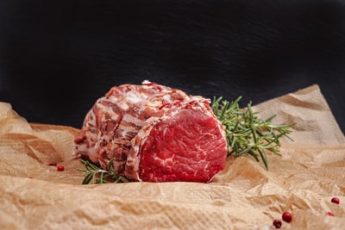
When you’re cooking steak at home, you might be wondering how to use a meat thermometer. The good news is that there are many ways to use a meat thermometer. This article will help you pick the right one for the job. It’s not always easy, but following these tips can help you hit your target the first time. You can also use an IR camera to determine the coolest part of the steak.
The most common mistake people make is to try to stick the thermometer into the face of the steak by using tongs. The problem with this is that the probe can’t reach the center of the steak, and the meat will continue to cook after you remove it from the heat source. In order to get the most accurate reading, you should insert the thermometer from the top side. It’s also important to remember that steak is 75% water and 20% protein.
| Image | Price | Buy | Prime | Title |
|---|---|---|---|---|
Top Top
Top | Buy Now | PrimeEligible | MEATER SE: Smart Bluetooth Meat Thermometer | Long Wireless Range | for Oven, Grill, Kitchen, BBQ, Smoker, Air Fryer | Step-by-Step Recipes in App | Dual Sensors | Black Charger [2024 Release] | |
 Top
Top | Buy Now | PrimeEligible | MEATER Pro: Smart Bluetooth Wireless Meat Thermometer Digital | 1000°F Heat Resistance | Long Range | Certified Accuracy | BBQ, Oven, Grill, Smoker, Air Fryer, Deep Fryer | 50+ Recipes in App | |
 Top
Top | Buy Now | PrimeEligible | MEATER Block: WiFi Smart Wireless Meat Thermometer | 4 Probes, Long Range | Perfect for BBQ, Oven, Grill, Kitchen, Smoker, Air Fryer | Apple Watch, Alexa Compatible | iOS & Android App | |
 Top
Top | Buy Now | PrimeEligible | Wireless Meat Thermometer Digital: Smart Multi Sensors Accuracy Bluetooth WiFi Food Thermometer with Ultra-Thin Probes for Cooking, BBQ,Oven, Grill, Smoker, Heat Resistance| Long Range| Fast Charging | |
 Top
Top | Buy Now | PrimeEligible | MEATER | The Original True Wireless Smart Meat Thermometer for the Oven Grill Kitchen BBQ Smoker Rotisserie with Bluetooth and WiFi Digital Connectivity | |
 Top
Top | Buy Now | PrimeEligible | ThermoPro TempSpike Plus 600FT Wireless Meat Thermometer with Upgraded Ultra-Thin Probe, Bluetooth Meat Thermometer Wireless for Outside Grill, Smoker Thermometer for BBQ Oven Rotisserie Sous Vide |
As an Amazon Associate we earn from qualifying purchases.
To avoid a false alarm, you should place the thermometer at least halfway up the thickness of the steak. If you don’t want to do this, then place the thermometer halfway up the thickness of the steak. The thermometer should read 32oF, but if you get a reading lower than this, you can adjust the temperature according to the manufacturer’s instructions. However, you should remember that a beef thermometer is likely to be inaccurate. To avoid this, you should consider putting it in a glass of ice water for 30 seconds or even two minutes before you start cooking.
When cooking meat, it is essential to pay attention to temperature gradients. In other words, the center of a steak may be much hotter than the rest of the steak. Using a meat thermometer on a steak should be done when the crust is the darkest and the center is still cool. A good temperature for a cooked steak should be 145 degF. If your food is undercooked, it will dry out and become tough.
In addition to using a meat thermometer to check the temperature of a steak, you can also use a meat thermometer to check the temperature in a variety of other foods. Besides cooking a steak, you can also use spit-roasted chicken or ground-ground beef. To cook a steak, you need to reach a certain temperature inside the meat. Then, you’ll know whether it is ready for consumption.
When using a meat thermometer on a steak, you’ll want to keep it out of the bone. Aside from being unsanitary, it can also damage the steak. If you’re using a meat thermometer on a piece of beef, it’s best to avoid touching the meat while it’s cooking to avoid the risk of damaging it. When cooking a rib-eye steak, the meat thermometer should be placed inside the thickest part of the food.
Another great advantage of a meat thermometer is its ability to accurately measure the internal temperature of a steak. Traditionally, roasting a bird is an art. By using a meat thermometer, you can make sure that the bird is cooked properly. In addition to preventing the risk of bacteria, it also helps ensure the safety of the meat. The ideal internal temperature for a steak is 140 degrees.
In addition to checking the internal temperature of your steak, you should also check its moisture content. A low-quality thermometer will be useless if it is not properly calibrated. A low-quality meat thermometer will cause your steak to become tougher. In addition, a meat thermometer will not give an accurate temperature for your steak. But if you’re cooking a steak, you can use a digital one.
The main benefit of a meat thermometer is that it prevents the risk of overcooking your meat. When you’re cooking a steak, it’s essential to select high-quality cuts that are healthy for you. It is important to choose the highest quality possible. When you’re cooking a steak at home, you’ll want to make sure the internal temperature is 145 degrees. It’s also important to remember that the USDA recommends using a meat thermometer on your steak at home.












